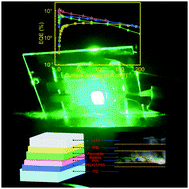Interfacial engineering for highly efficient quasi-two dimensional organic–inorganic hybrid perovskite light-emitting diodes†
Abstract
Metal halide-based perovskites are regarded as promising candidates for light-emitting diodes (LEDs) owing to their high color purity, tunable bandgap and solution processability. However, poor active-layer morphology and non-radiative charge recombination are still the main obstacles for practical use in displays and lighting. Here, we report a facile method to achieve high-performance green emitting perovskite light-emitting diodes (PeLEDs) by inserting an interface buffer layer (BL) based on an amphipathic conjugated molecule, betaine. We show evidence that the betaine layer controls the grain size of the perovskite and hence increases the crystalline nucleation sites, which ultimately leads to a high photoluminescence quantum yield (PLQY) and a device with an external quantum efficiency (EQE) of 11.1%. In addition, the current leakage is significantly reduced due to the high quality crystallization of the thin film. These results indicate that the interface BL is an effective strategy to boost the efficiency of PeLEDs.

- This article is part of the themed collection: International Year of the Periodic Table : From Pb and Sn Perovskites to the Next Generation


 Please wait while we load your content...
Please wait while we load your content...